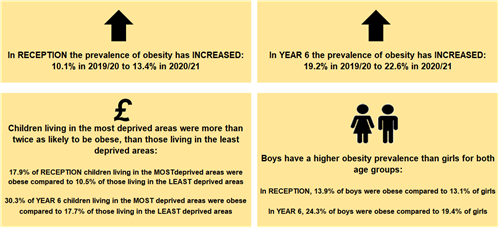Healthy weight and healthy eating
Obesity and excess weight
Obesity is a leading cause of ill health; an independent risk factor for cardiovascular diseases such as heart disease and stroke, as well as increasing the likelihood of developing other risk factors such as hypertension (high blood pressure) and type II diabetes.
Obesity is commonly measured using weight and height to give a Body Mass Index (BMI) metric. Poor diet (containing a high proportion of foods high in fat, sugars and salt) and lack of exercise can lead to obesity, which in turn is a risk factor for non-communicable diseases such as cardiovascular disease and some forms of cancer.
More than one in seven 6 year olds and one in four 11 year olds are obese in Herefordshire
In England, child BMI is measured at Reception Year (age 4 to 5 years) and Year 6 (aged 10 to 11 years) through the mandatory National Child Measurement Programme (NCMP). For the majority of children excess weight gain is the result of eating more calories than needed and/or undertaking too little physical activity to match calorie intake, or a combination of both.


For more detail see National Child Measurement Programme, England 2020/21 School Year
Two thirds of adults overweight and one in ten obese
In 2019/20, 61.3% of adults in Herefordshire were estimated to be overweight or obese, similar to the national figure of 62.8% although lower than that reported for the West Midlands (66.8%). Comparison with GP records indicates that it is highly probable that obesity prevalence is under-recorded.
According to Quality and Outcomes Framework (QOF) in 2020/21 approximately 11,200 adults registered with a Herefordshire general practitioner (GP) practice were obese, which represents 7.2% of all patients aged 18 years and over, a higher proportion than that reported for England.
Fruit and vegetable consumption higher than across England and the West Midlands
In 2019/20 almost two thirds of Herefordshire adults consumed five or more portions of fruit or veg on a daily basis. The average number of portions of fruit and vegetables consumed daily by Herefordshire adults is higher than those reported national and regionally.
There has been little change in recent years in the consumption of fruit and veg by children with 1 in 2 routinely eating the recommended ‘5 a day’ fruit and vegetables, although this rate is higher than that seen across England. However, secondary pupils who are eligible for free school meals are less likely to eat vegetables most days (36% vs. 52%).